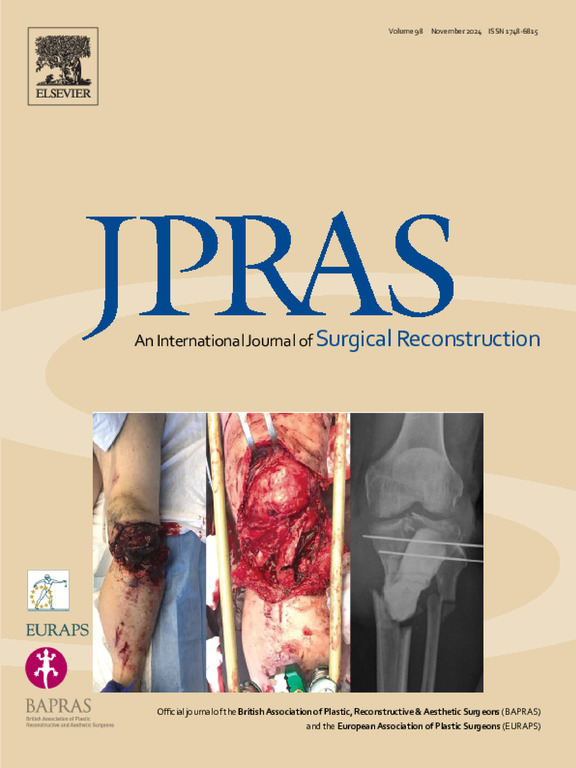IF 2
3区 医学
Q2 SURGERY
Journal of Plastic Reconstructive and Aesthetic Surgery
Pub Date : 2025-03-22
DOI:10.1016/j.bjps.2025.03.045
引用次数: 0
摘要
面神经麻痹(FNP)会破坏面部肌肉的神经输入,其中最主要的是负责眨眼的肌肉。这种损失通常会导致不适、角膜暴露,如果治疗不当,还会导致视力丧失。FNP 通常表现为单侧性,导致脸部不对称,给患者带来痛苦和社交孤立。自然闭合仿生眼睑植入物(BLINC)的开发目的是通过上眼睑吊带机械驱动眼睑运动,恢复 FNP 患者的眨眼功能,重点是恢复自然对称的外观。为了将这种新型干预措施推向临床应用,需要一个可靠的动物模型来评估这种装置的功能和安全性,并优化 BLINC 的手术植入。之所以选择绵羊,是因为绵羊的眼眶在解剖学大小和形状上与人类相似,有利于测试人类大小的植入物。四只绵羊接受了面神经切除术,随后在颞窝植入了 BLINC。术后评估证实,手术恢复顺利,瘫痪诱导有效,没有额外的功能障碍,支持使用这种绵羊面神经瘫痪模型来评估新型干预措施。这项研究证明了在大型动物模型中手术植入 BLINC 装置的可行性,为进一步测试和最终应用于人类奠定了基础。本文章由计算机程序翻译,如有差异,请以英文原文为准。
Surgical approach to model facial nerve paralysis in an ovine model for in vivo testing of a novel intervention
Facial nerve paralysis (FNP) disrupts neural inputs to the facial muscles, the most significant being those responsible for blinking. This loss often results in discomfort, corneal exposure, and if improperly treated, vision loss. FNP typically presents unilaterally, resulting in an asymmetric face, causing distress and social isolation. The Bionic Lid Implant for Natural Closure (BLINC) was developed to restore functional blinking in patients with FNP by mechanically actuating eyelid movement via an upper eyelid sling, with a focus on restoring a natural and symmetric appearance. To move this novel intervention toward clinical application, a reliable animal model was needed to assess the function and safety of such a device and optimize the surgical implantation of BLINC. The sheep was chosen owing to the anatomical size and shape similarities of the orbit relative to humans, lending to the testing of human-sized implants. Four sheep underwent facial nerve resection and subsequent BLINC implantation in the temporal fossa. Postoperative assessments confirmed uneventful surgical recovery and effective paralysis induction with no additional functional deficits, supporting the use of this ovine model of FNP for the assessment of novel interventions. The study demonstrates the feasibility of surgical implantation of the BLINC device in a large animal model, laying the groundwork for further testing and eventual human application.
求助全文
通过发布文献求助,成功后即可免费获取论文全文。
去求助
来源期刊
CiteScore
3.10
自引率
11.10%
发文量
578
审稿时长
3.5 months
期刊介绍:
JPRAS An International Journal of Surgical Reconstruction is one of the world''s leading international journals, covering all the reconstructive and aesthetic aspects of plastic surgery.
The journal presents the latest surgical procedures with audit and outcome studies of new and established techniques in plastic surgery including: cleft lip and palate and other heads and neck surgery, hand surgery, lower limb trauma, burns, skin cancer, breast surgery and aesthetic surgery.

 求助内容:
求助内容: 应助结果提醒方式:
应助结果提醒方式:


